The Ultimate Guide To Getting Rid Of Your Knee Pain
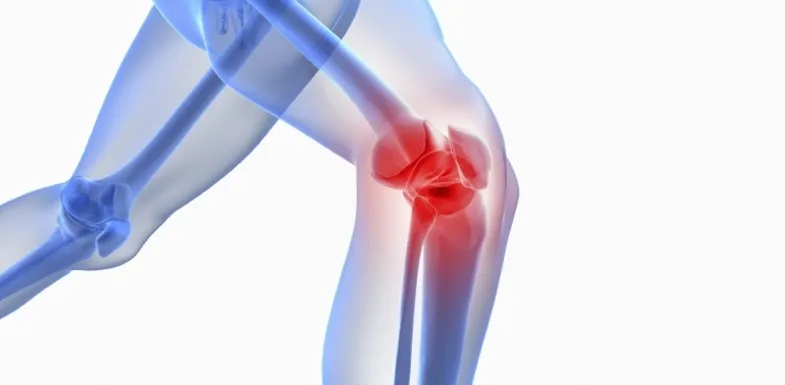
Learn the cause of your knee pain and how to get rid of it for good. Discover what you need to know to get yourself back to better than normal.
What you will learn:
Inside this guide are the key components to understanding and effectively attacking knee pain. Getting rid of it for good involves first finding the cause, then putting together a clear plan to eliminate it.
This guide discusses:
- Top 3 Causes of Knee Pain
- Self-tests for Knee Pain
- Movement Challenge
- Top 3 Exercises for Knee Pain
- Top 3 Stretches for Knee Pain
- Top 3 Behavior Modifications for Knee Pain
- Knee Pain Quiz
- Movement Script
- Infographic
Top 3 Causes of Knee Pain
Knee pain is caused by one or a combination of these three main causes…
Patellofemoral pain syndrome (PFPS)
Sometimes called “runners knee,” this is used to describe pain around the patella (kneecap) and in front of the knee. This is common in people who participate in sports that require running or jumping. Individuals at a higher risk include women due to having a wider pelvis which puts increased stress at the knee joint, younger children playing sports, as well the elderly due to the natural degenerative process that goes on at the knee cap. As you age, the back side of the knee cap tends to wear down causing increased pain with bending motions of the knee. Symptoms of PFPS include dull aching pain in the front of the knee which can be aggravated with walking up or down stairs, kneeling, squatting, or sitting for periods of time.
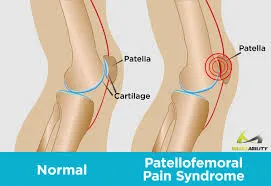
Causes of PFPS include
Overuse – Running or jumping sports put repetitive stress on your knee and can cause irritation under your patella.
Muscle imbalance or weakness – When the muscles surrounding your hip and knee are weak, they often do not keep your patella properly aligned which can cause irritation to the knee.
Trauma – Trauma to the patella, such as dislocation or fracture, has been known to cause PFPS due to malalignment.
Repeated job related stress – If you have a job that requires you to do a lot of bending, kneeling or stair/ladder climbing, you are more likely to have PSFS as you age. Same goes for doing a lot of bending around the house like in gardening, yard work, and housekeeping.
How you can prevent PFPS injuries
Maintain strength of all muscles surrounding your knees, ankles and hips.
Ensure good technique and hip-knee-ankle alignment while bending, lifting and squatting in your daily activities.
Lose excess weight.
Stretch – make sure the muscles surrounding the knee are at their proper length.
Increase intensity of exercise / activity gradually.
Ensure you have proper fitting shoes.
Osteoarthritis
This is your classic “wear and tear” of the knee. As your knee arthritis progresses, bony spurs also develop in and around your knee joint in response to the change in load biomechanics.
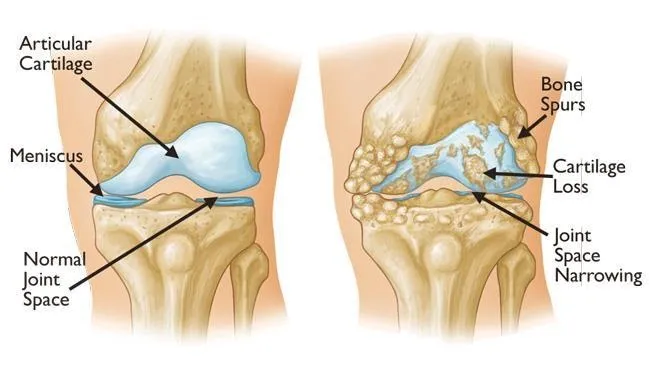
Common causes of OA
Increasing age.
Above average weight.
Genetics – if your parents had bad knees, you might be more likely to have them too.
Previous knee injuries. If you had knee injuries from playing sports in your youth, you are more likely to have knee arthritis as you age.
Jobs or sports that repeatedly load the knee. So bending, squatting, lifting, walking / climbing on uneven surfaces, stairs or ladders.
Common symptoms of OA
Gradual onset of knee pain that is worse in the morning or after a period of inactivity such as sitting for a long period of time followed by getting up.
Knee pain with weightbearing tasks such as walking and stair-climbing.
Knee stiffness or swelling.
Clicking or grinding/grating.
Decreased strength of the lower leg muscles.
Hip external rotation weakness.
Treatment may include
- Normalizing range of motion of the entire lower extremity.
- Strengthen muscles in the hips, core, knees and ankles.
- Normalize muscle length through soft tissue mobilization and stretching.
- Improve balance and proprioception.
- Improve functional tasks such as squatting, lifting and push/pull tasks.
Meniscus Irritation
Your meniscus is fibrocartilage that separates the femur (upper leg bone) from your tibia (lower leg bone). It acts as a shock absorber as we walk, run and jump so that these forces don’t damage the bone surfaces.
Each knee joint has a medial (inner side) meniscus and lateral (outer side) meniscus. The medial meniscus is more likely to be injured because it is firmly attached to the medial collateral ligament (MCL) and joint capsule. The meniscus is commonly torn or injured when the knee is in a compromised position such as twisting on a slightly flexed knee. Natural age-related degeneration of the meniscus can also cause pain and limited range of motion.
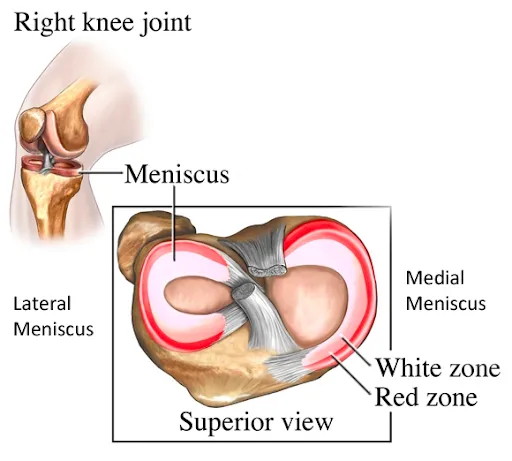
How you’ll know if you have a possible meniscal tear
- Painful popping, clicking or locking of the knee.
- Pain with squatting, especially at the end of the range of motion.
- Tenderness to touch along the joint line of the knee on examination.
- Unable to fully bend or straighten out the knee.
Can your meniscus heal on its own?
Meniscus tear healing is dependent on the blood supply where the tear is. There are two “zones” that determine whether or not it will heal on its own.
- Red Zone – The red zone has blood supply, which means it can naturally heal. The outer edge of the meniscus has blood supply from the joint capsule.
- White Zone – This is where the meniscus doesn’t have much or any blood supply and won’t heal naturally. Due to this, the inner meniscus does not usually heal and can trigger an inflammatory response which can require surgical attention.
Self-tests for knee pain:
During a physical therapy examination, your therapist will perform tests to rule in or rule out causes of your pain, no matter what body part is bothering you. There are dozens of knee pain special tests, but here are a few that you can perform on yourself at home.
Movement Challenge
Is there a test you can do to see just how healthy your knees are? A physical challenge is a great way to test out your knees. Think of it as an inspection for your car. Each year you need to bring your car in to have your mechanic make sure that everything is in good running condition. The same concept holds for your knees.
The Test: Deep Squat Test
Stand with your feet about shoulder width apart or the normal distance you would use to squat down.
Keep your toes pointing straight ahead or up to about 15 degrees out to the side.
Squat down bending your knees as far as they can comfortably go. Think about getting the hips as close to the ankles as you can.
Try to hold this position for as long as you can while maintaining your heels down on the ground, your knees out over your second toe, and your spine in neutral with your head up.
Start Position
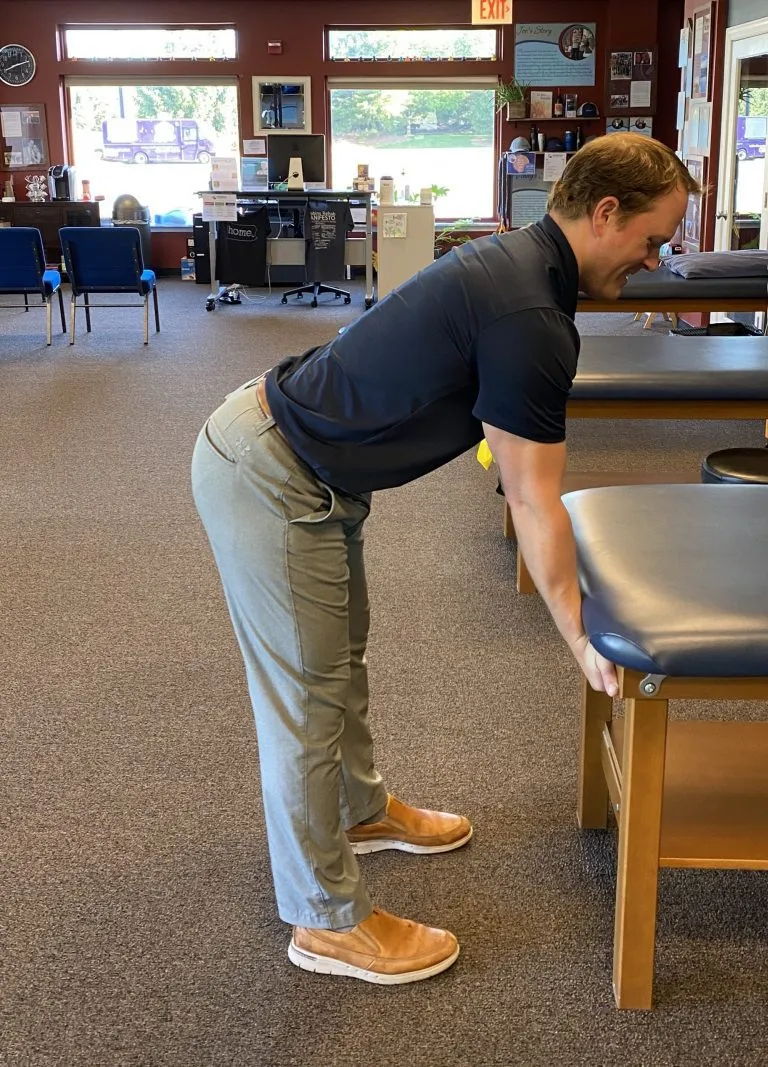
End Position

Pass or Fail? Did you hold the test for a full 2:00?
Your Results
If you are able to maintain the position for two minutes, great job! It is likely that you have developed the proper range of motion through the knee and lower extremities as well as strength in leg muscles to avoid knee pain. If you were unable to maintain a deep squat hold for that amount of time, you could use some mobility and strength work to your legs and you are at a higher risk of developing knee pain.
How do I get better at this test?
Improving your score on this test is simple. Practice the deep squat hold and try to improve your time. Another simple trick is to hold onto something as this can help balance you out to pull down into the position. Even if you can only hold the position for a few seconds, that’s OK! Nowhere to go but up! Keep working on this along with the top 3 exercises for getting rid of knee pain and your knee strength and range of motion will continue to improve.
Top 3 exercises for knee pain:
There are hundreds of exercises we could have put in this section. Depending on what is causing your knee pain, some of these exercises might help and some might not. It is important to realize that if any of these exercises are increasing your pain, you should not do them. Also, prescribing exercise is much like prescribing medication. The type of exercise and amount of exercise is very important. Without a full examination by one of our physical therapists, it’s difficult to prescribe exercises that will take away your pain. The exercises below were selected to help decrease knee pain, no matter what the cause is, but it is only a “best guess” and not an actual prescription based on an examination.
Sit to stand
Begin by sitting on the front half of a stationary chair. Place both feet on the floor about shoulder width apart with your knees bent to 90 degrees and toes straight. From this position stand straight up squeezing the glutes and then sit back down on the chair. Repeat for suggested times.
Suggested program: Repeat 10-20 times and do them 1-2x per day.
Start Position
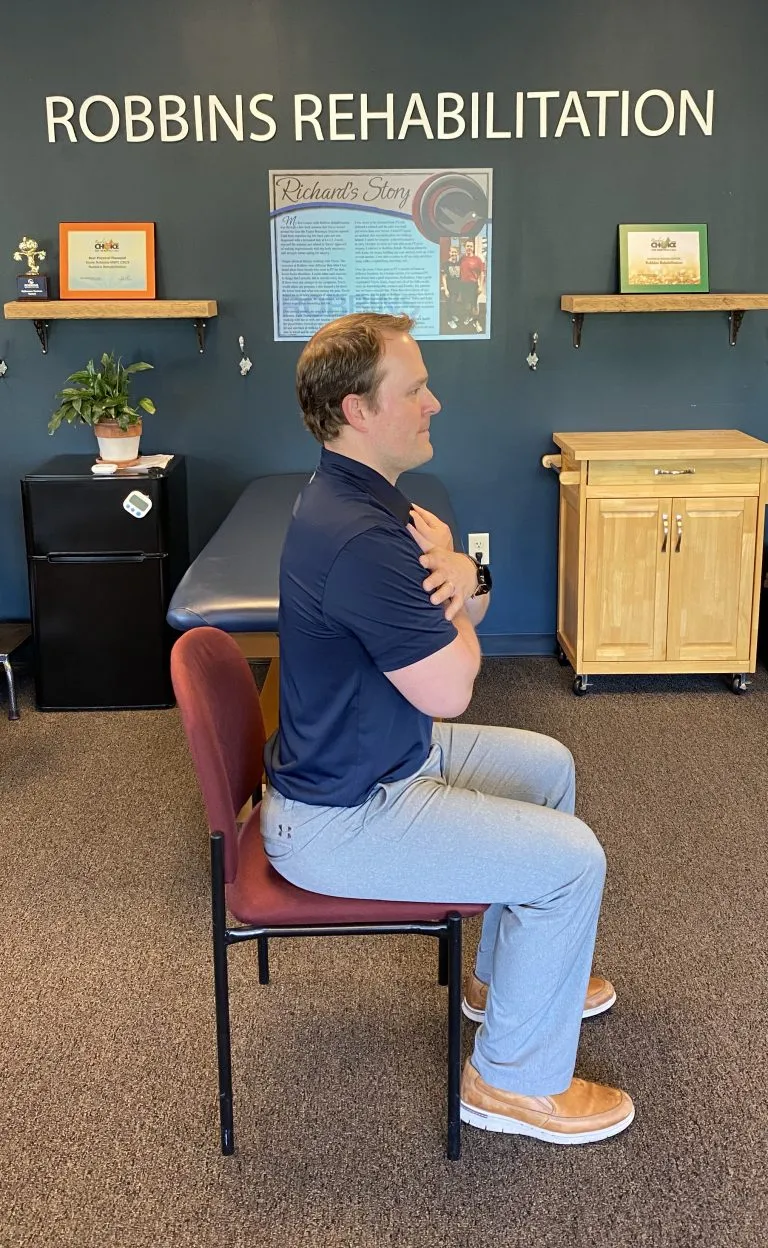
End Position
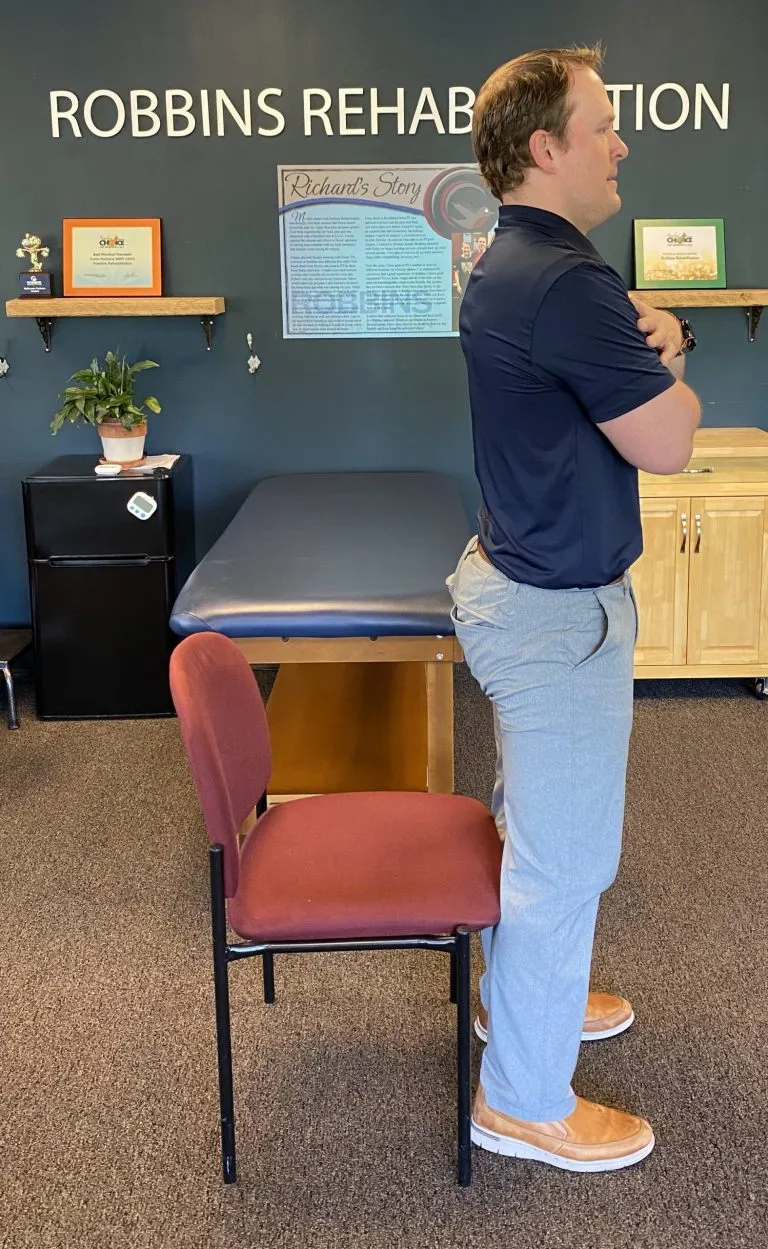
Bridges
Lying on your back, bend both legs so your feet are flat on the floor. Tighten your abdomen and lift your hips up into the air squeezing your buttox. Hold this position steady and return to the starting position.
Suggested program: Repeat this 10-20 times holding for 5 seconds and do this 1-2x per day.
Start Position
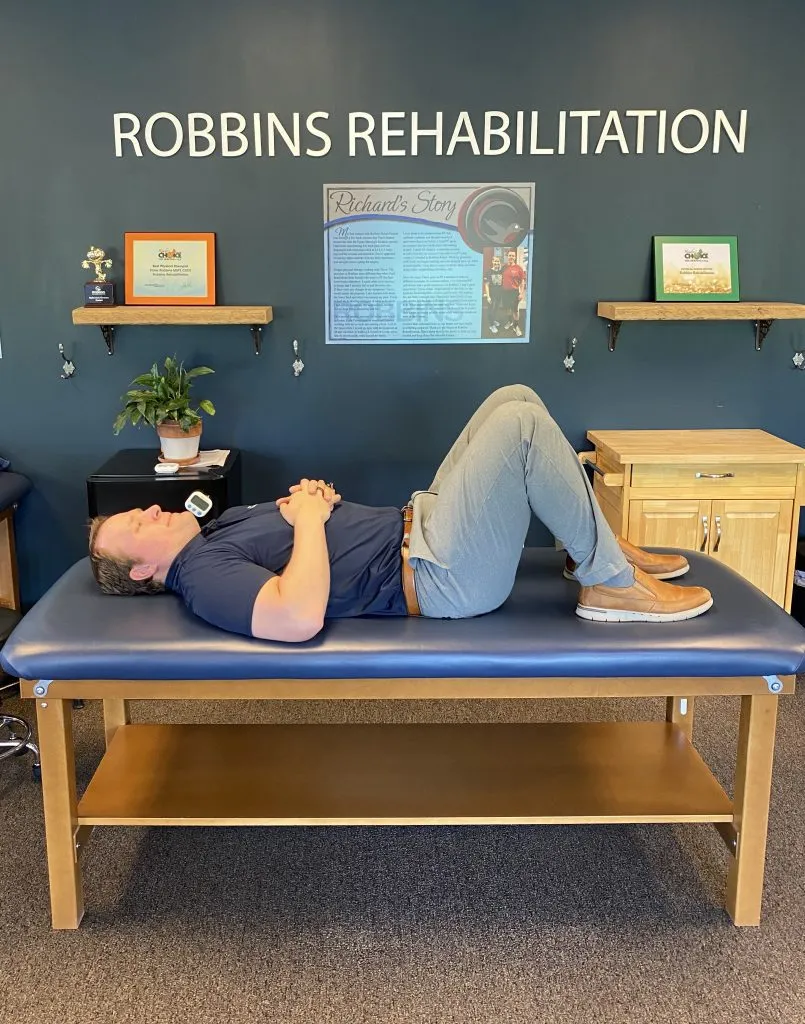
End Position
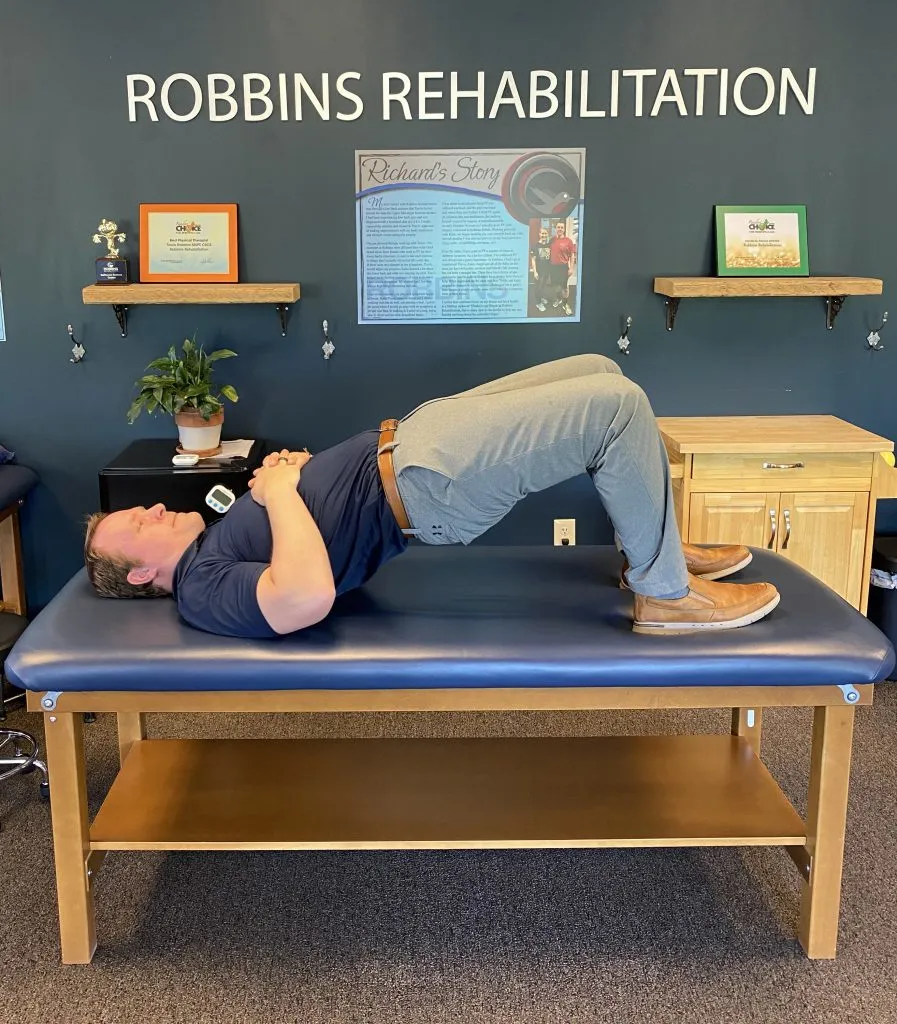
Clamshells
Lying on your side (doesn’t matter which one to start) with both knees bent to a 90 degree angle with hips and knees stacked on each other. Keeping your feet together, lift your top knee up without rotating the top hip back. Hold this position steady and return to the starting position.
Suggested program: Repeat this 5-10 times on each side holding for 10 seconds and do this 1-2x per day.
Start Position
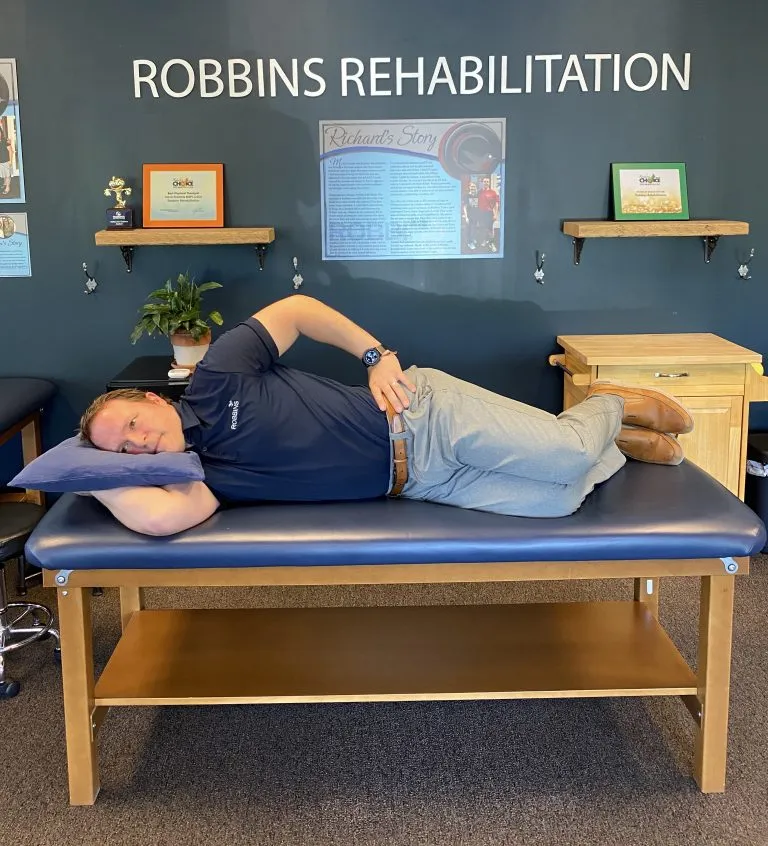
End Position
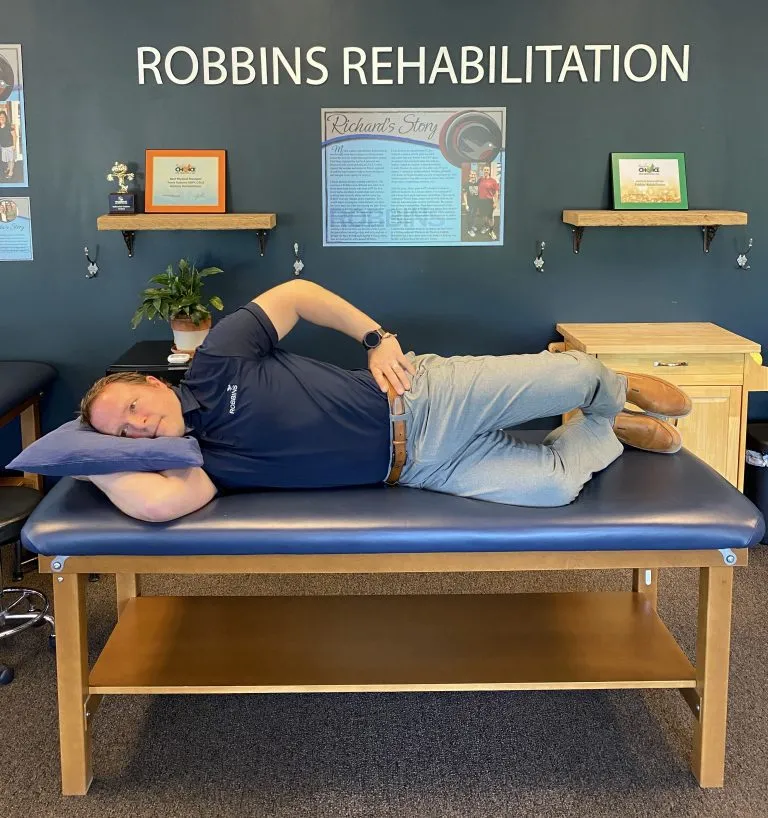
Top 3 stretches for knee pain:
A word on stretches…
A stretch is designed to lengthen muscle tissue to allow for greater range of motion. In order to do this, the holds for a stretch need to be a minimum of 2 minutes. Holding for only 20-30 seconds will not get the job done.
Lacross ball hamstring release
Sitting on the edge of a table with your legs hanging off the edge, place the double lacrosse ball under your hamstring (back of your thigh). Kick your leg out 4-5 times as long as you have no pain and then roll the balls up your hamstring. Continue until you cover the length of the hamstring and then work your way back down until time is up.
Suggested program: 2 minutes per each hamstring moving the balls every 5 reps, complete 1 time per day on each side.
Start Position

End Position

Prone quad stretch
Lying on your stomach, wrap a strap, belt or towel around your ankle and pull towards your butt until you feel a gentle stretch in front of your thigh. Make sure you are not arching your back as you pull your leg.
Suggested program: Hold for a 2 minute stretch, complete 1 time per day on each side.
Start Position
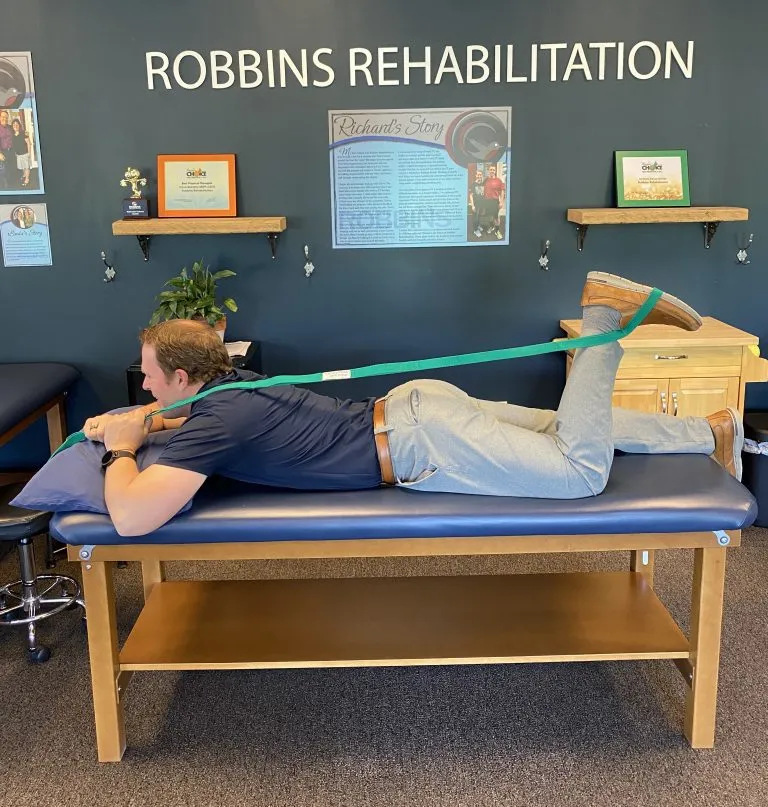
End Position
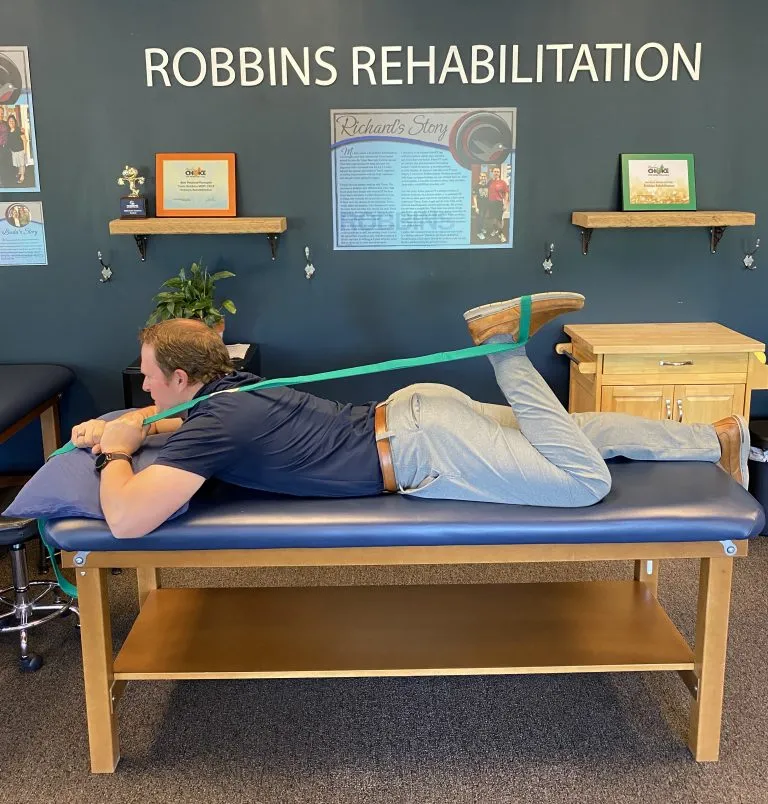
Standing gastroc stretch
Standing at a table or wall, put one leg back so you are in a staggered stance. Keeping your back leg straight and your heel on the ground, bend your front knee until you feel a stretch in the calf.
Suggested program: Hold for a 2 minute stretch, complete 1 time per day on each side.
Start Position
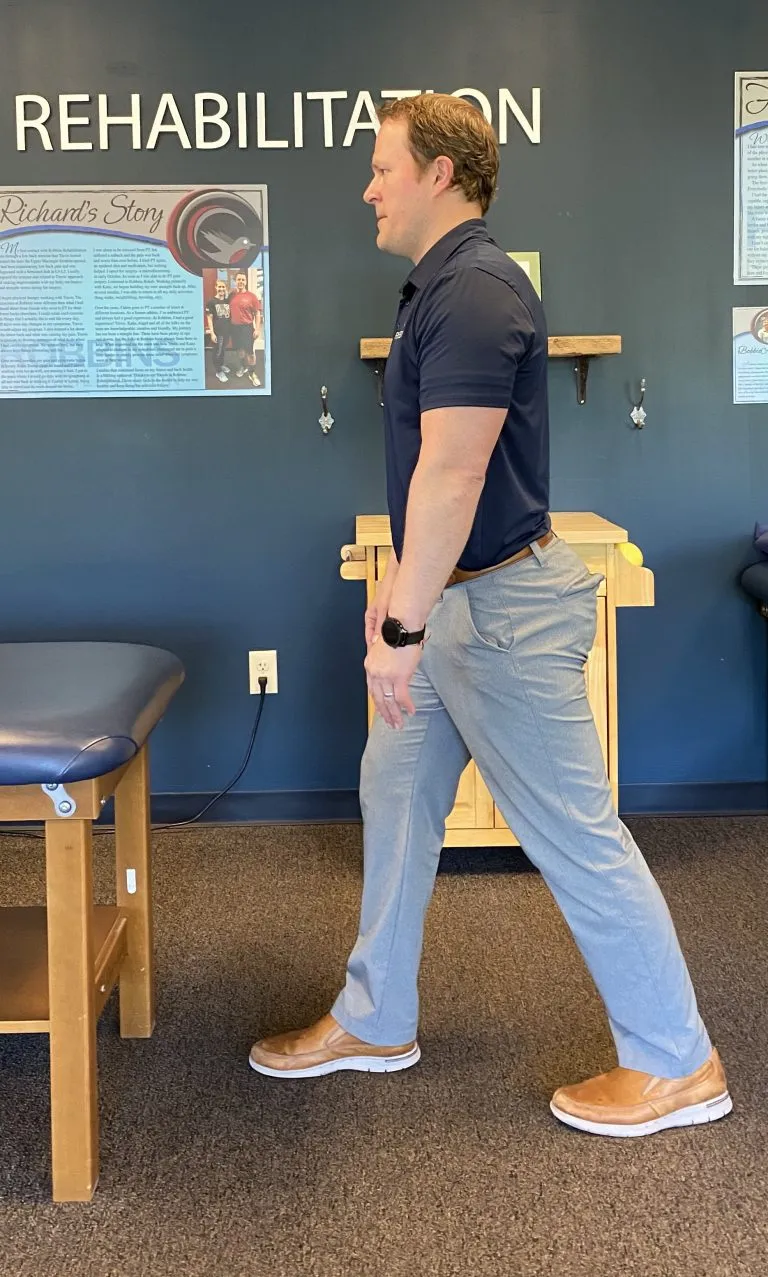
End Position
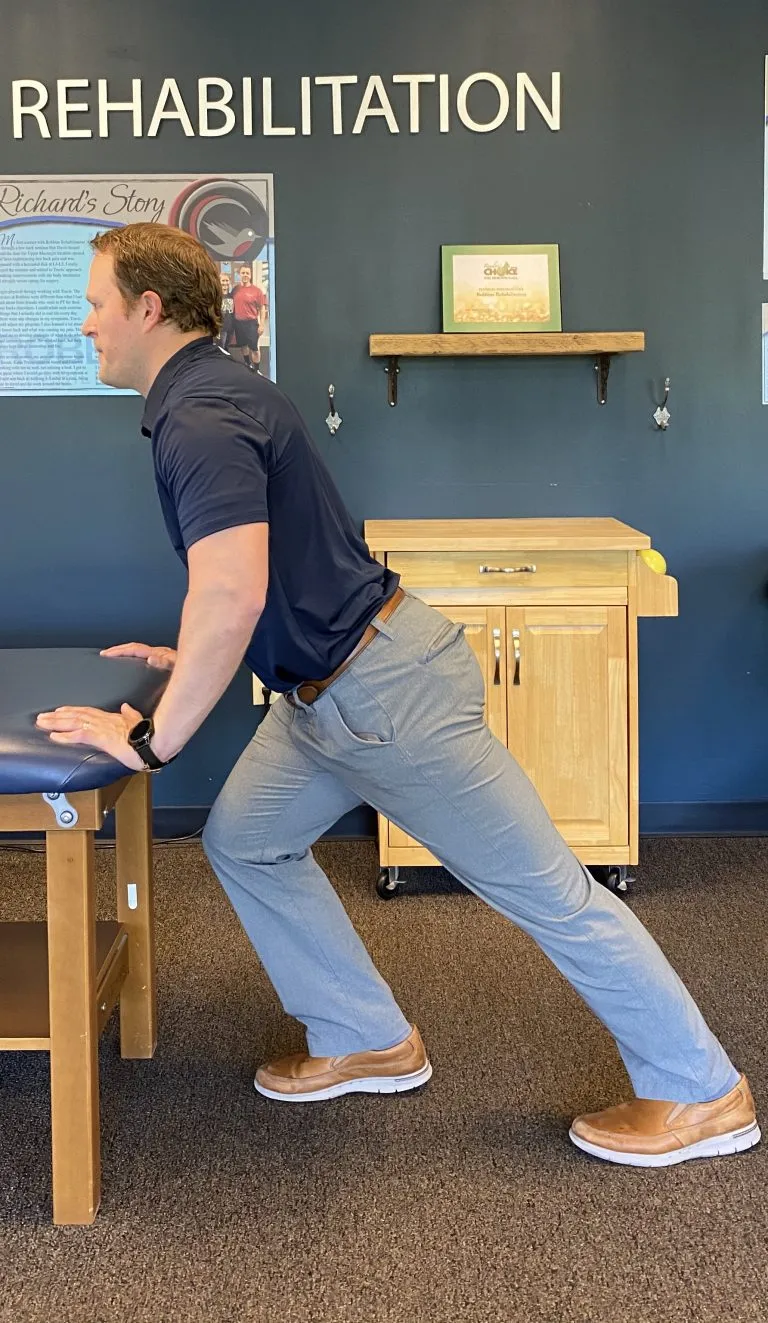
Top 3 behavior modifications for knee pain:
There are hundreds of exercises we could have put in this section. Depending on what is causing your knee pain, some of these exercises might help and some might not. It is important to realize that if any of these exercises are increasing your pain, you should not do them. Also, prescribing exercise is much like prescribing medication. The type of exercise and amount of exercise is very important. Without a full examination by one of our physical therapists, it’s difficult to prescribe exercises that will take away your pain. The exercises below were selected to help decrease knee pain, no matter what the cause is, but it is only a “best guess” and not an actual prescription based on an examination.
Here are some quick tips to help you get rid of your knee pain fast no matter what the cause. These concepts are simple, but not easy. It will take some adjustment on your part, but it’s worth the investment.
Stop taking the shortcut…
The modern lifestyle has most of us moving less and less. Our economy has moved into knowledge work, meaning many jobs that require movement (physical labor) have gone away. So, we have to add movement into our daily routine to counteract our sedentary lives. This doesn’t have to be running 10 miles or going to the gym for hours on end. Simple solutions like a walk with your dog or other loved one, taking the stairs instead of the elevator or even parking as far away from the grocery store as you can are little changes you can make to add more movement into your day.
Make sure you are doing exercises with proper form.
If you already have an exercise program that you are following, that’s great! Another way to increase your risk of injury is doing exercises incorrectly – seek out a trainer or physical therapist to make sure you are doing exercises in a safe fashion. This will also help you make gains quicker because you are actually targeting the right muscles. The biggie for the knees is don’t let them collapse inside your foot/ankle (go in towards each other) as you are getting up or down in any squat movement or when doing any step movement you follow the same rules.
Keep moving throughout the day.
If you know your symptoms worsen with prolonged inactivity – keep moving throughout the day. An easy habit you can build is to run your entire lower body through a full range of motion several times throughout your day using a bodyweight squat routine. Simply set a timer at home or work for 60 minutes. When the timer goes off, do 10 body weight squats. Do 10 squats every 60 minutes and you will have quite a few squats by the end of the day! Don’t over think things… just go from standing to squatting through as much range of motion as you can (get your hips as low to the ground as you can with your feet straight ahead, knees out) and stand back up! This low intensity full range of motion exercise keeps the joints flexible and strengthens the muscles you need to keep knee pain away.
Knee Pain Quiz
Take this quick 6 question quiz to get an idea of what your next steps should be to eliminate your knee pain.
Movement Script
Our Movement Script is a 28 day program to get you back to normal. It’s the prescription your knee has been looking for so that you can get back to doing all the things you used to do before you had knee pain. It’s made up of 3 main components – a mobility plan, an exercise plan and a behavior modification plan.
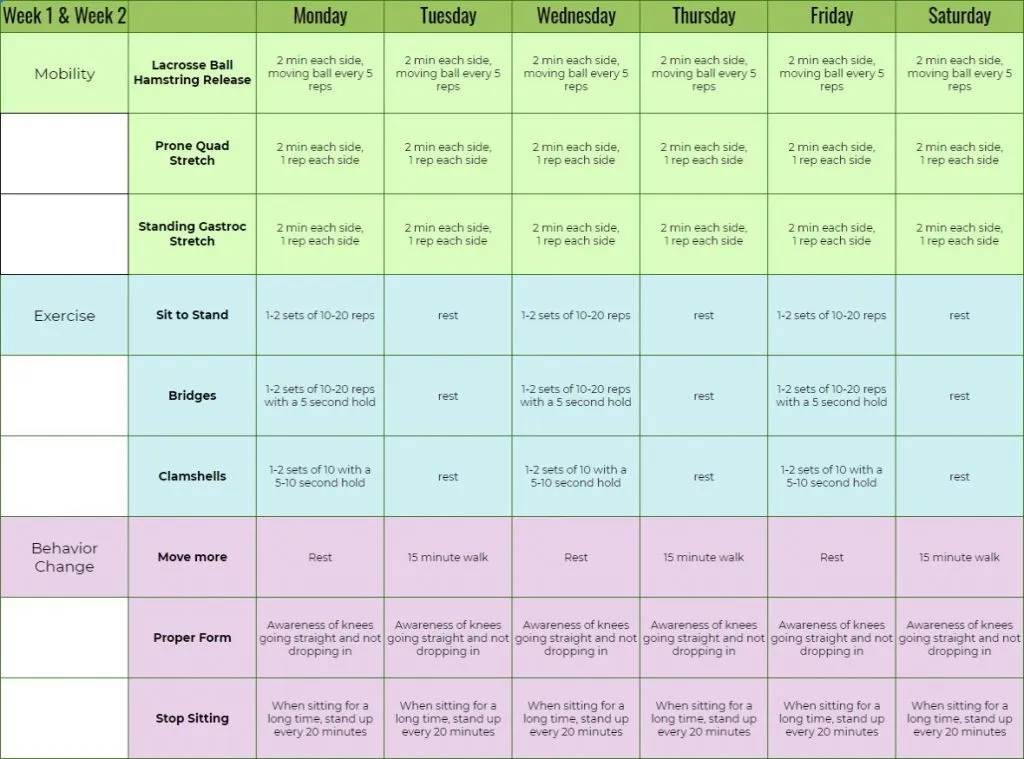
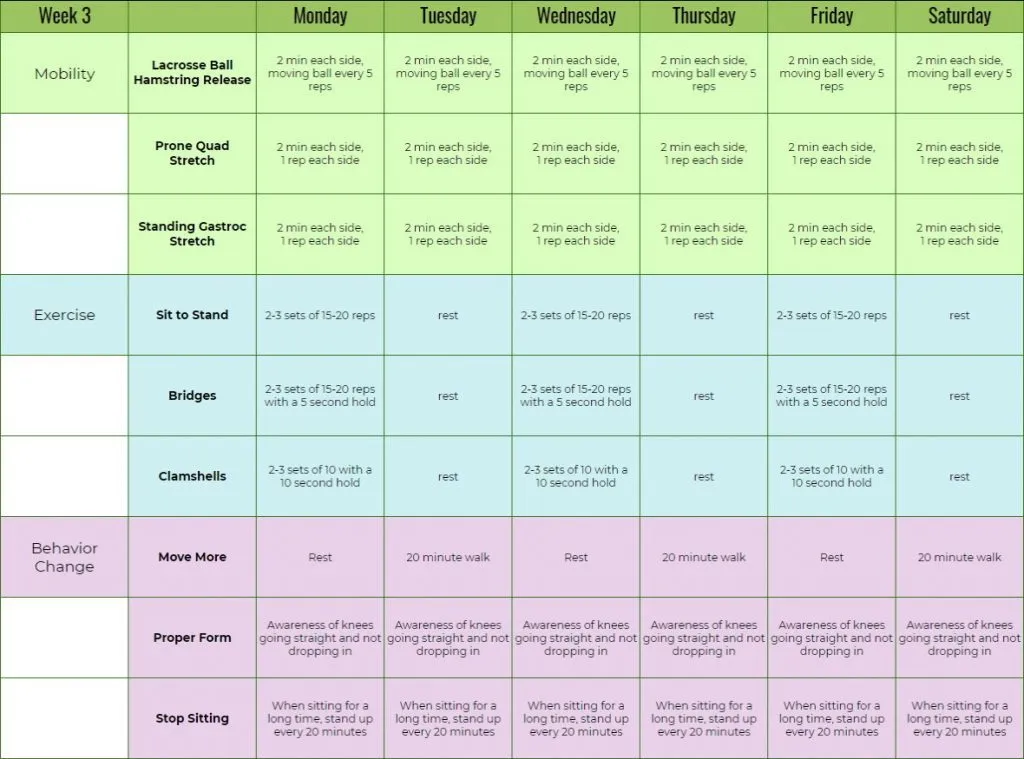
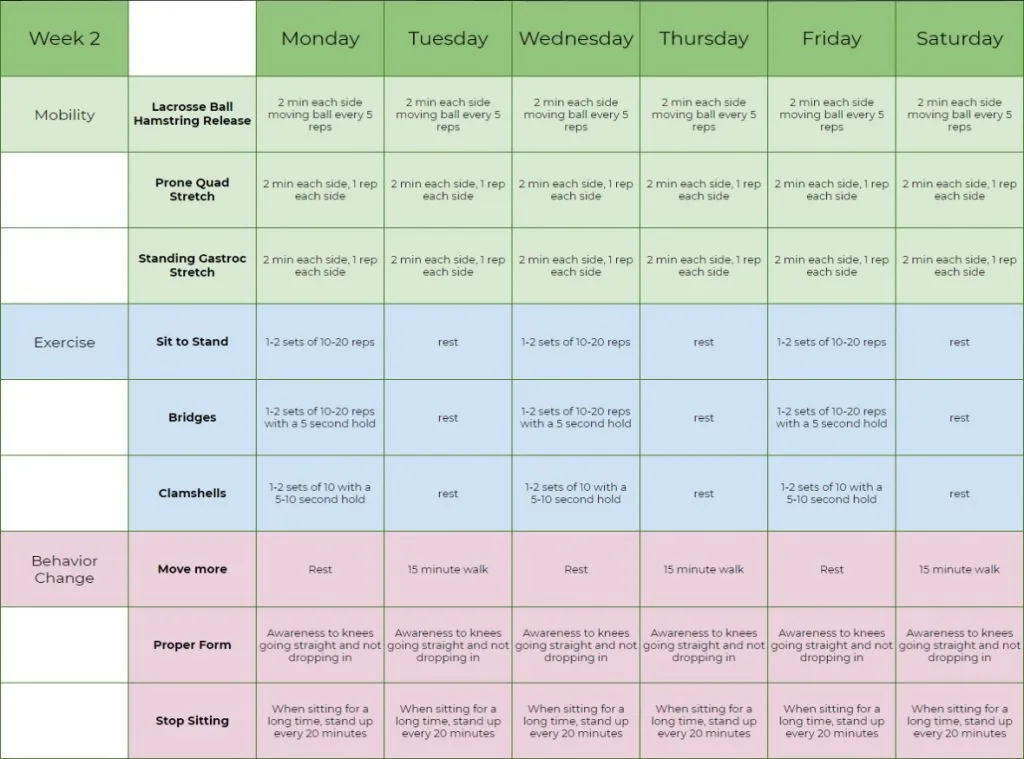
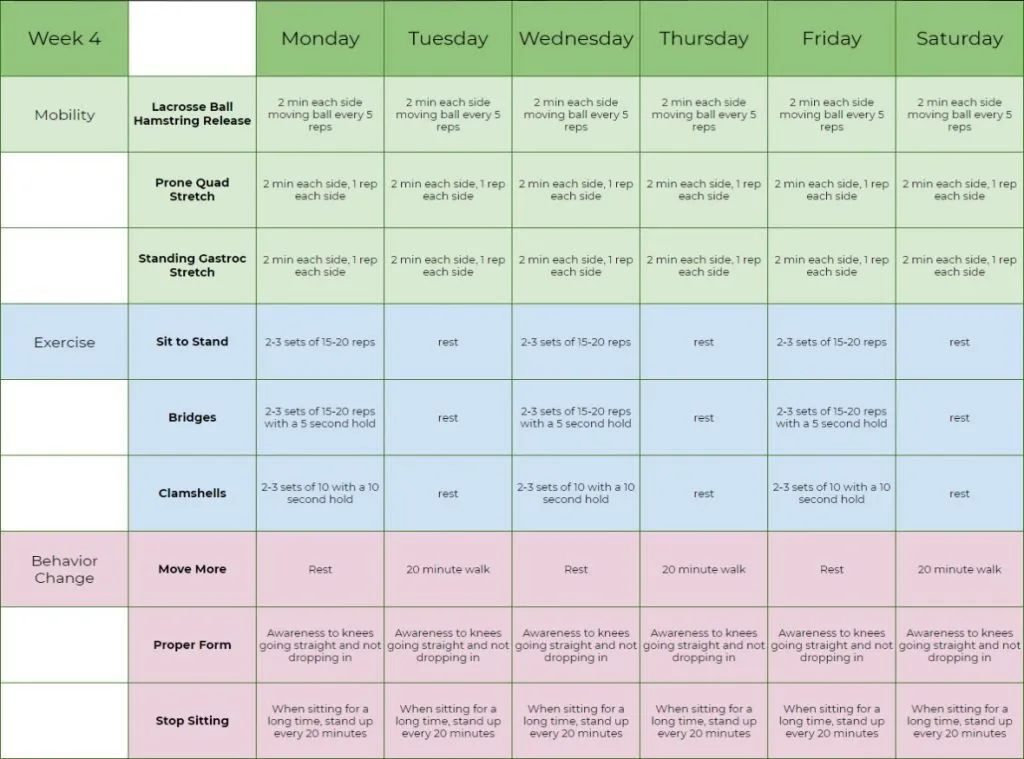
Infographic
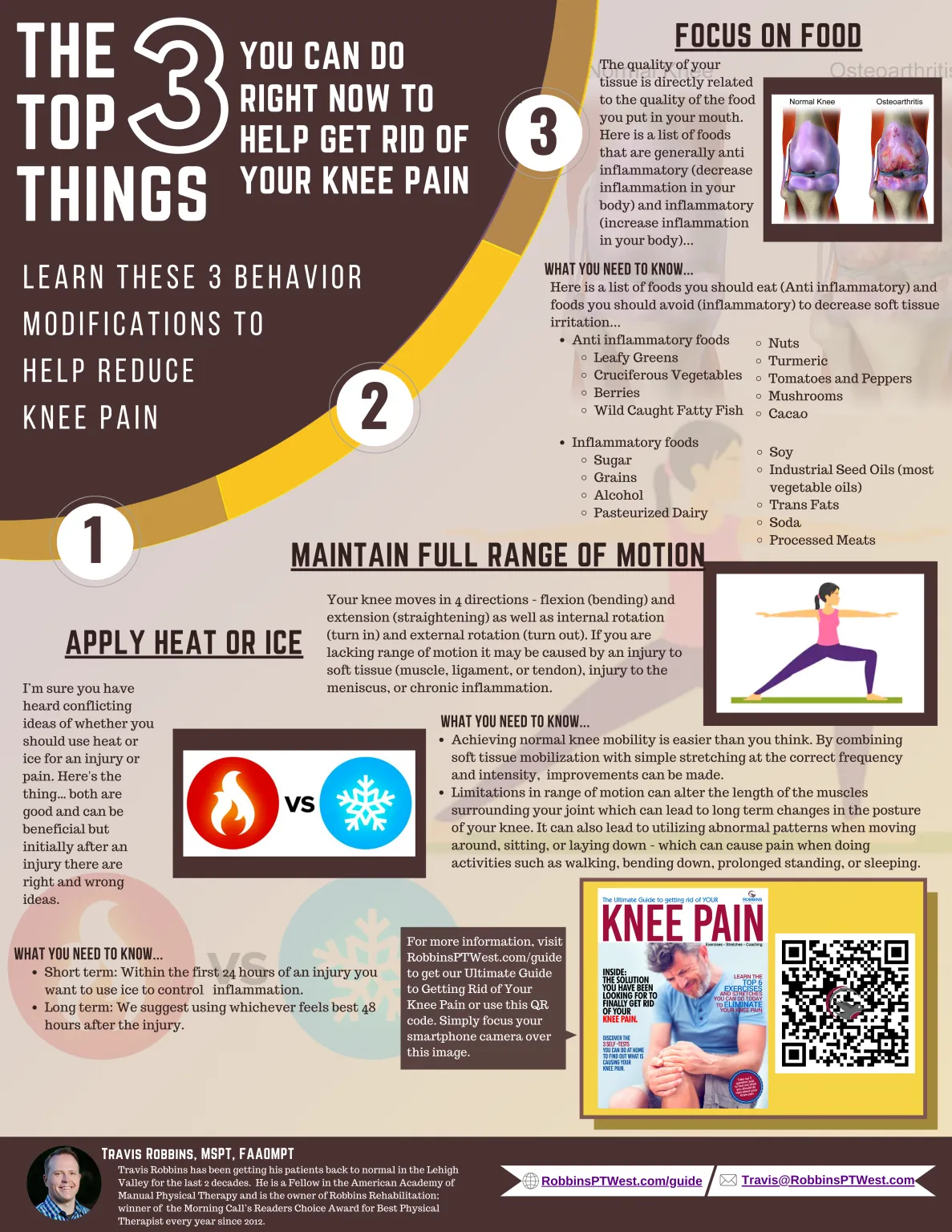
References
Sugai, Keiko, et al. “Association between knee pain, impaired function, and development of depressive symptoms.” Journal of the American Geriatrics Society 66.3 (2018): 570-576.
Roos, Harald, et al. “Osteoarthritis of the knee after injury to the anterior cruciate ligament or meniscus: the influence of time and age.” Osteoarthritis and Cartilage 3.4 (1995): 261-267.
Coggon, D., et al. “Knee osteoarthritis and obesity.” International journal of obesity 25.5 (2001): 622-627.
Dixit, Sameer, et al. “Management of patellofemoral pain syndrome.” American family physician 75.2 (2007): 194-202.
Willy, Richard W., et al. “Patellofemoral pain: Clinical practice guidelines linked to the international classification of functioning, disability and health from the Academy of Orthopaedic Physical Therapy of the American Physical Therapy Association.” Journal of Orthopaedic & Sports Physical Therapy 49.9 (2019): CPG1-CPG95.
Logerstedt, David S., et al. “Knee pain and mobility impairments: meniscal and articular cartilage lesions revision 2018: Clinical Practice Guidelines Linked to the International Classification of Functioning, Disability and Health From the Orthopaedic Section of the American Physical Therapy Association.” Journal of Orthopaedic & Sports Physical Therapy 48.2 (2018): A1-A50.
Cibulka, Michael T., and Julie Threlkeld-Watkins. “Patellofemoral pain and asymmetrical hip rotation.” Physical therapy 85.11 (2005): 1201-1207.
Herrington, Lee. “Knee valgus angle during single leg squat and landing in patellofemoral pain patients and controls.” The Knee 21.2 (2014): 514-517.
Agarwal, Bela, et al. “Influence of varying squat exposure on knee pain and function among people with knee osteoarthritis.” Critical Reviews™ in Physical and Rehabilitation Medicine 31.1 (2019).
Chin, Carson, et al. “Quadriceps weakness and risk of knee cartilage loss seen on magnetic resonance imaging in a population-based cohort with knee pain.” The Journal of rheumatology 46.2 (2019): 198-203.
Joshi, Shabnam, and Vikram Singh Yadav. “Knee Joint Muscle Flexibility in Knee Osteoarthritis Patients and Healthy Individuals.” International Journal of Health Sciences and Research 9.6 (2019): 156-163.
Roddy, E., W. Zhang, and M. Doherty. “Aerobic walking or strengthening exercise for osteoarthritis of the knee? A systematic review.” Annals of the rheumatic diseases 64.4 (2005): 544-548.
